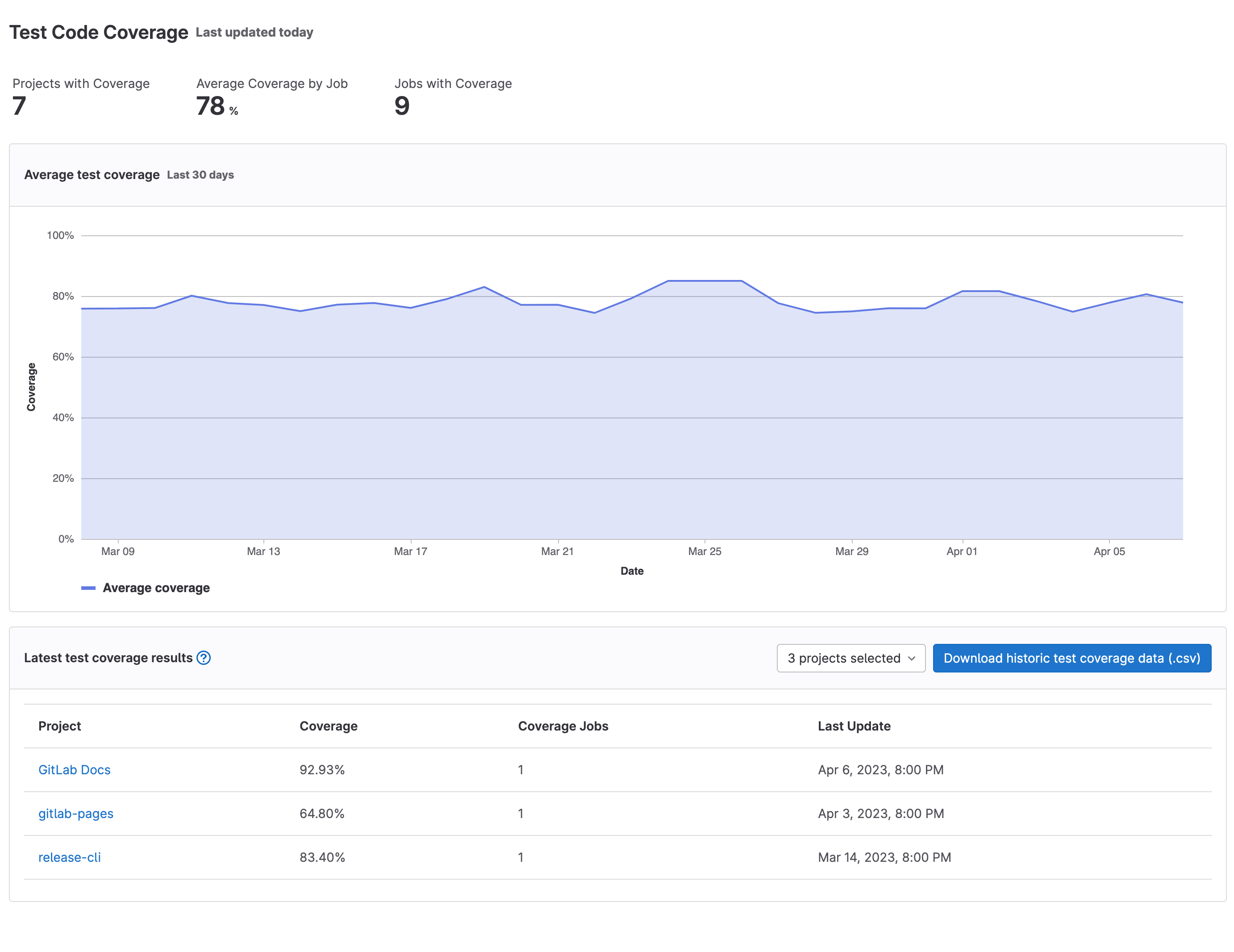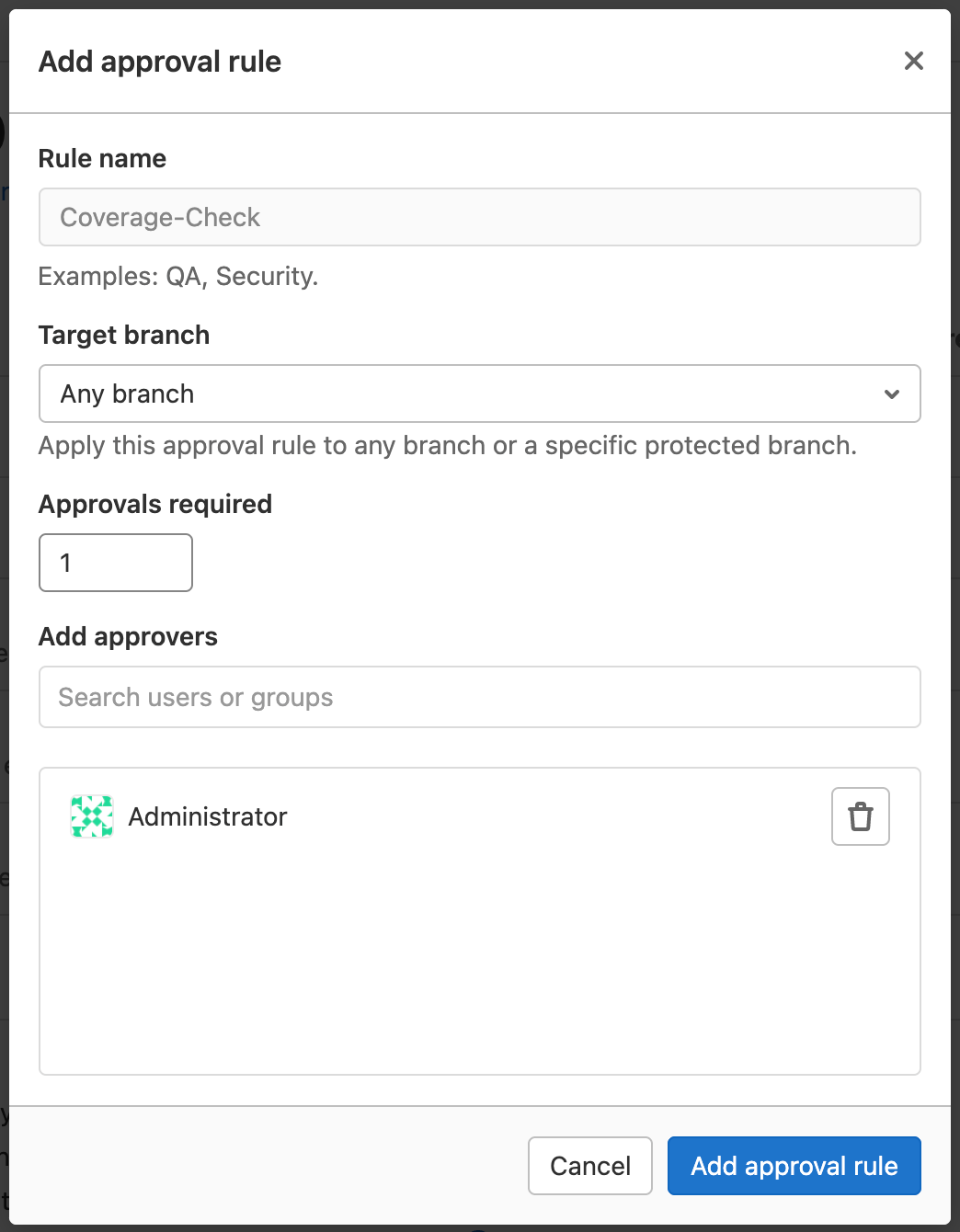Code coverage
DETAILS: Tier: Free, Premium, Ultimate Offering: GitLab.com, Self-managed, GitLab Dedicated
Use code coverage to provide insights on what source code is being validated by a test suite. Code coverage is one of many test metrics that can determine software performance and quality.
View Code Coverage results
Code Coverage results are shown in:
- Merge request widget
- Project repository analytics
- Group repository analytics
- Repository badge
For more information on test coverage visualization in the file diff of the MR, see Test Coverage Visualization.
View code coverage results in the MR
If you use test coverage in your code, you can use a regular expression to find coverage results in the job log. You can then include these results in the merge request in GitLab.
If the pipeline succeeds, the coverage is shown in the merge request widget and in the jobs table. If multiple jobs in the pipeline have coverage reports, they are averaged.
Add test coverage results using coverage keyword
To add test coverage results to a merge request using the project's .gitlab-ci.yml file, provide a regular expression
using the coverage keyword.
Test coverage examples
The following list shows sample regex patterns for many common test coverage tools. If the tooling has changed after these samples were created, or if the tooling was customized, the regex might not work. Test the regex carefully to make sure it correctly finds the coverage in the tool's output:
- Simplecov (Ruby). Example:
/\(\d+.\d+\%\) covered/. - pytest-cov (Python). Example:
/TOTAL.*? (100(?:\.0+)?\%|[1-9]?\d(?:\.\d+)?\%)$/. - Scoverage (Scala). Example:
/Statement coverage[A-Za-z\.*]\s*:\s*([^%]+)/. -
pest --coverage --colors=never(PHP). Example:/^\s*Cov:\s*\d+\.\d+?%$/. -
phpunit --coverage-text --colors=never(PHP). Example:/^\s*Lines:\s*\d+.\d+\%/. - gcovr (C/C++). Example:
/^TOTAL.*\s+(\d+\%)$/. -
tap --coverage-report=text-summary(NodeJS). Example:/^Statements\s*:\s*([^%]+)/. -
nyc npm test(NodeJS). Example:/All files[^|]*\|[^|]*\s+([\d\.]+)/. -
jest --ci --coverage(NodeJS). Example:/All files[^|]*\|[^|]*\s+([\d\.]+)/. - excoveralls (Elixir). Example:
/\[TOTAL\]\s+(\d+\.\d+)%/. -
mix test --cover(Elixir). Example:/\d+.\d+\%\s+\|\s+Total/. - JaCoCo (Java/Kotlin). Example:
/Total.*?([0-9]{1,3})%/. -
go test -cover(Go). Example:/^coverage: (\d+.\d+)% of statements$/. - .NET (OpenCover). Example:
/(Visited Points).*\((.*)\)/. - .NET (
dotnet testline coverage). Example:/Total\s*\|\s*(\d+(?:\.\d+)?)/. - tarpaulin (Rust). Example:
/^\d+.\d+% coverage/. - Pester (PowerShell). Example:
/Covered (\d+\.\d+%)/.
View history of project code coverage
- Introduced the ability to download a
.csvin GitLab 12.10.- Graph introduced in GitLab 13.1.
To see the evolution of your project code coverage over time, you can view a graph or download a CSV file with this data.
- On the left sidebar, select Search or go to and find your project.
- Select Analyze > Repository analytics.
The historic data for each job is listed in the dropdown list above the graph.
To view a CSV file of the data, select Download raw data (.csv).
View history of group code coverage
DETAILS: Tier: Premium, Ultimate Offering: GitLab.com, Self-managed, GitLab Dedicated
To see the all the project's code coverage under a group over time, you can find view group repository analytics.
Pipeline badges
You can use pipeline badges to indicate the pipeline status and test coverage of your projects. These badges are determined by the latest successful pipeline.
Coverage check approval rule
DETAILS: Tier: Premium, Ultimate Offering: GitLab.com, Self-managed, GitLab Dedicated
- Introduced in GitLab 14.0.
- Made configurable in Project Settings in GitLab 14.1.
When merging a request that would cause the project's test coverage to decline, you can stipulate that such merge requests require approval by selected users or a group.
Follow these steps to enable the Coverage-Check MR approval rule:
- Set up a
coverageregular expression for all jobs you want to include in the overall coverage value. - Go to your project and select Settings > Merge requests.
- Under Merge request approvals, select Enable next to the
Coverage-Checkapproval rule. - Select the Target branch.
- Set the number of Approvals required to greater than zero.
- Select the users or groups to provide approval.
- Select Add approval rule.
Troubleshooting
Remove color codes from code coverage
Some test coverage tools output with ANSI color codes that aren't parsed correctly by the regular expression. This causes coverage parsing to fail.
Some coverage tools do not provide an option to disable color codes in the output. If so, pipe the output of the coverage tool through a one-line script that strips the color codes.
For example:
lein cloverage | perl -pe 's/\e\[?.*?[\@-~]//g'



